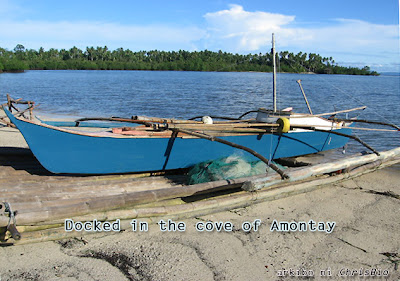N.B. - The Kamayo poem after this article was written in 2008.
One thing I share in common with my father is our growing interest in writing Kamayo poetry. Two years ago, when I asked him to write a poem for the Balik-Marihatag newsletter, I saw his face lit up with excitement. He grabbed his pen at once and wrote a series of metrical writing in Kamayo – a poem he entitled “Layat-layatan”. It was an amusing poem of two parts, uniquely Marihatagnon for it contained names like Pisaw, Tarin, Puwahan, Mantika, Liswit, Kagwang – all twit names we use to call someone instead of their first names, sometimes a collective “layat” for a certain clan.
One thing I share in common with my father is our growing interest in writing Kamayo poetry. Two years ago, when I asked him to write a poem for the Balik-Marihatag newsletter, I saw his face lit up with excitement. He grabbed his pen at once and wrote a series of metrical writing in Kamayo – a poem he entitled “Layat-layatan”. It was an amusing poem of two parts, uniquely Marihatagnon for it contained names like Pisaw, Tarin, Puwahan, Mantika, Liswit, Kagwang – all twit names we use to call someone instead of their first names, sometimes a collective “layat” for a certain clan.
The eternal Omagon spirit has been witness to the unfolding
of generations.
of generations.
Sa una na panahon
Ang kanatu mga ginikanan
Kalipay ang mag layat-layatan
Abu da haw magkatipon da gani siran
The last lines in the second part were pieces of imagination, a fictitious product of a Marihatagnon’s mind who remains unflustered by layat-layatan.
Gapabuto ng Bulog
Kinargahan ng pulbura
Adto pasingud sa tubig
Yangabungog ang mga Pisaw,
Boriring, ug Latab
Yangahug ang mga Bayabas
Itangag ng Kwahaw
Ihuwesan ng Buwakaw
I remember writing an entry to a Kamayo-poem writing competition sponsored by the hosts of the 2002 Pakighimamat. The competition received a good number of entries and we were made to read our works on stage.
I take pride in that first literary piece I wrote in Kamayo, and I’m sure the many others who wrote their works must have felt the same – a sense of ownership of each word in every line, for we speak the language that represents the heart and soul of a Kamayo.
Writing in the vernacular is marked by profound insight, as one is able to go deep into each word and its meaning. The fluidity in expressing the ideas is lucid for the language is embedded deep in the person.
Indeed, there is “there is truth in spirit”. And that spirit of the language that we speak defines us, creating an embodiment of what Marihatagnons are truly like.
Hain Da Kaw?
Pira pa ka tuig ang yalabay
Sukad pagbiya mo
Ani sa lang ako… gatagad, yanghamay
Basin kadi mabalik pa kaw
Kay amo say gisaad mo
Yauso ra lang and cellphone ug text
Wara sa gayud lagbong mo na yabalik
Basin matahay da lang ang suba sa Tugbungan
Diri mo gayud ako kadumduman
Dayaw pa ang hinangkan
Mauli haw mahapon sa punoan
Haw diri da kaw gayud kanako
Pagpatigam lang…
Sarig kay ang buhok ko sa alipudhan
Maihap da kuman




